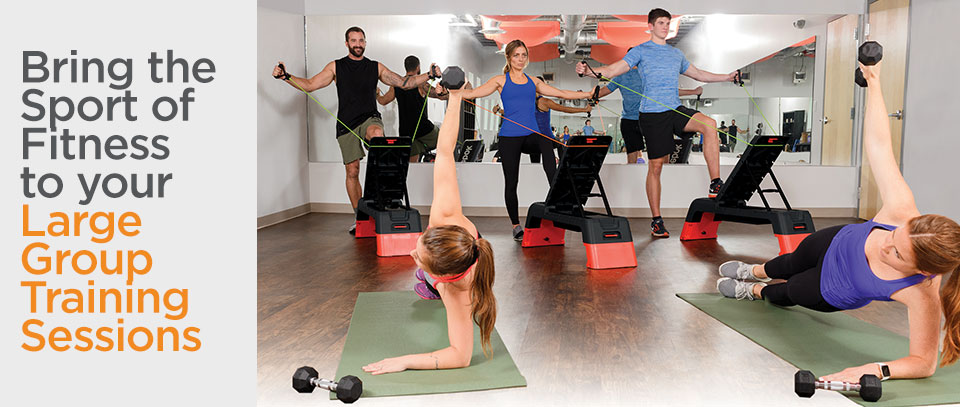The language of fitness is changing. People don’t just “workout” anymore, they “train”. Personal trainers don’t just “train” anymore, they “coach”.
Speaking of, what is the difference between a “coach” and a “trainer” anyways? In the fitness industry, those terms are often used interchangeably; however, if you ask 10 different people to explain the difference, you would likely get 10 different answers. Perhaps the most obvious difference is in association: a coach is to sports as a trainer is to fitness. But among the rapidly growing trend of “the sport of fitness”, more trainers are coaching groups of everyday athletes to maximize their potential in pursuit of fitness goals.
 Small and large group training is becoming more of the norm in health, fitness, and recreational facilities. These groups start to take on the look and feel of a team in training as they motivate each other. Group training can enhance participant experience by providing consistency and an additional level of accountability. Whether you are participating in, leading, or supporting a training group of any size, you will undoubtedly be enlightened and energized by some of the very large (up to almost 100 people at a time) group training that goes on in Power Systems Master Coach Bennie Wylie, Jr.’s performance training center in Abilene, TX.
Small and large group training is becoming more of the norm in health, fitness, and recreational facilities. These groups start to take on the look and feel of a team in training as they motivate each other. Group training can enhance participant experience by providing consistency and an additional level of accountability. Whether you are participating in, leading, or supporting a training group of any size, you will undoubtedly be enlightened and energized by some of the very large (up to almost 100 people at a time) group training that goes on in Power Systems Master Coach Bennie Wylie, Jr.’s performance training center in Abilene, TX.
Tip 1: Giving your group a name and give the members ownership.
Naming your group makes the members feel like they are part of a team. Simply referring to the group as athletes can build their confidence and motivate them to push themselves and each other. Bennie refers to everyone at The Performance Lab as “athletes” or more affectionately, the “LabRats”. This team environment thrives on the athletic coaching principles Bennie and his staff coaches apply to this group.
Tip 2: Put visibility and coach awareness of the group training cycles to increase member retention.
Using the similar programming schedules from his experience in professional and collegiate athletics, Bennie and his team start to speak the same language. For example, each week of a three-week training cycle is referred to by coaches and athletes alike as either the “learn it, know it, or own it” week. Developing awareness and visibility of training cycles within your group can increase group member retention as the athletes begin to understand that each week has a focus and purpose that drives them closer to their goals.
Tip 3: Grow your circle of influence from 2 people to 20 people by implementing large group training circuits.
In the Grow Your #FitFam blog series, we examined some of the barriers to entry into group fitness classes. Adequate space and equipment was one of the concerns listed among group training regulars as well as those considering joining a group. As you start to grow your small group to a large group, be prepared to invest in more quantities of versatile training tools such as kettlebells, medicine balls, mats, dumbbells, and resistance tubes.
Increasing your equipment inventory from 2-5 of each piece to 8-10 of each piece will ensure none of your members will ever experience the “odd person out” and everyone will have all they need to be successful. This investment will pay for itself quickly as your circle of influence grows like a ripple-effect. Group members that attend regularly will get results and will be eager to share those with their friends both in person and on social media.
As the sport of fitness grows, so does the #fitfam community of people that gravitate towards others with common interests and goals. Whether working individually or together, this group thrives on the motivation from their peers during their workout or from reading their #flexfriday posts. For more detail on how to mobilize and motivate large groups of people towards their goals, here is where you can attend Bennie Wylie’s education session “Coaching vs. Training, How to Design Athletic Based Circuits for All Clients”:
IDEA World Convention – Las Vegas Convention Center – Saturday, July 22 – 7:30 AM-9:20 AM
Club Industry Show – Hilton Chicago – October 4-6, 2017
And stay tuned for more details later this month on when you can see Bennie coach his large group of “LabRats” live from The Performance Lab.

You must be logged in to post a comment.